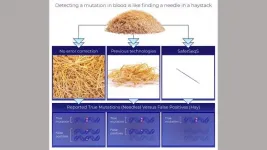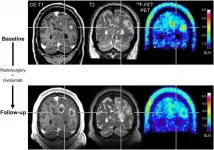Your stomach may be the secret to fighting obesity
2021-05-04
(Press-News.org) Scientists believe a stomach-specific protein plays a major role in the progression of obesity, according to new research in Scientific Reports. The study co-authored by an Indiana University School of Medicine researcher, could help with development of therapeutics that would help individuals struggling with achieving and maintaining weight loss.
Researchers focused on Gastrokine-1 (GKN1) -- a protein produced exclusively and abundantly in the stomach. Previous research has suggested GKN1 is resistant to digestion, allowing it to pass into the intestine and interact with microbes in the gut.
In the Scientific Reports study, researchers show that inhibiting GKN1 produced significant differences in weight and levels of body fat in comparison to when the protein was expressed.
"While diet and exercise are critical to maintaining a healthy weight, some individuals struggle with weight loss -- even in cases of bariatric surgery, maintaining weight loss can be a challenge," said David Boone, PhD, associate professor of microbiology and immunology at IU School of Medicine, an adjunct professor in the Department of Biology at the University of Notre Dame and a co-author of the study. "These results are an example of how a better understanding of the gut microbiome and the physiological aspects of obesity -- how our bodies regulate metabolism and accumulate body fat -- could help inform new therapies."
Data from the Centers for Disease Control show adult obesity rates have increased to 42.4 percent in the United States. In addition to increasing an individual's risk of stroke, diabetes, certain cancers and other health issues, obesity can also increase the risk of severe illness due to COVID-19.
Boone and his team conducted a microbiome analysis of mouse models with and without the GKN1 protein expressed. Researchers measured food intake, caloric extraction, blood sugar, insulin and triglyceride levels. They used magnetic resonance imagining to monitor body composition. The team also calculated energy expenditure and observed inflammation levels.
Models without GKN1 weighed less and had lower levels of total body fat and higher percentages of lean mass -- despite consuming the same amount of food. When put on a high-fat diet, models without GKN1 showed a resistance to weight gain, increased body fat and hepatic inflammation, which can lead to liver disease. Researchers also found no evidence of adverse effects such as cancer, diabetes, loss of appetite, malabsorption or inflammation -- and results were consistent in male and female models.
While more research is needed to determine the efficacy of blocking GKN1 to prevent obesity, researchers said if proved as a viable solution, such therapies could reduce the burden on health care systems and help improve quality of life for patients.
INFORMATION:
About IU School of Medicine
IU School of Medicine is the largest medical school in the U.S. and is annually ranked among the top medical schools in the nation by U.S. News & World Report. The school offers high-quality medical education, access to leading medical research and rich campus life in nine Indiana cities, including rural and urban locations consistently recognized for livability.
ELSE PRESS RELEASES FROM THIS DATE:
2021-05-04
Next-generation gene sequencing (NGS) technologies --in which millions of DNA molecules are simultaneously but individually analyzed-- theoretically provides researchers and clinicians the ability to noninvasively identify mutations in the blood stream. Identifying such mutations enables earlier diagnosis of cancer and can inform treatment decisions. Johns Hopkins Kimmel Cancer Center researchers developed a new technology to overcome the inefficiencies and high error rates common among next-generation sequencing techniques that have previously limited their clinical application.
To correct for these sequencing errors, the research team from the Ludwig Center and Lustgarten Laboratory at the Johns Hopkins ...
2021-05-04
ROCHESTER, Minn. -- A pair of Mayo Clinic studies shed light on something that is typically difficult to see with the eye: respiratory aerosols. Such aerosol particles of varying sizes are a common component of breath, and they are a typical mode of transmission for respiratory viruses like COVID-19 to spread to other people and surfaces.
Researchers who conduct exercise stress tests for heart patients at Mayo Clinic found that exercising at increasing levels of exertion increased the aerosol concentration in the surrounding room. Then also found that a high-efficiency particulate air (HEPA) device effectively filtered out the aerosols and decreased the time needed to ...
2021-05-04
Reston, VA--For patients with brain metastases, amino acid positron emission tomography (PET) can provide valuable information about the effectiveness of state-of-the-art treatments. When treatment monitoring with contrast-enhanced magnetic resonance imaging (MRI) is unclear, adding 18F-FET PET can help to accurately diagnose recurring brain metastases and reliably assess patient response. This research was published in The Journal of Nuclear Medicine.
Newer treatment options for patients with brain metastases--such as immune checkpoint inhibitors and targeted therapies--are effective, but can cause a variety of side effects. ...
2021-05-04
The human immune system doesn't just protect our health, it reflects it. Each encounter with a potential disease-causing agent causes the body to produce specific immune agents -- proteins known as antibodies and T-cell receptors -- tailor-made to recognize and destroy the invader. Tasked with preventing re-infection, antibodies and T-cell receptors (TCR) from your previous encounters circulate throughout the body indefinitely, like a record of your personal medical history that you carry inside of you.
Clinical pathologist Ramy Arnaout, MD, DPhil, ...
2021-05-04
WASHINGTON, DC -- A new case report, detailed in Annals of Emergency Medicine, is the first known case of a patient with VITT (vaccine-induced thrombotic thrombocytopenia) treated with a heparin alternative following the Centers for Disease Control and Prevention (CDC) guidance.
An otherwise healthy female patient in her 40s came to the emergency department at UCHealth University of Colorado Hospital twelve days after receiving the Johnson & Johnson vaccine with a headache, dizziness, and vision changes. The patient was treated on April 13, 2021, the same day that the Centers for Disease Control and Prevention (CDC) announced a pause in the administration of the Johnson & Johnson vaccine. CDC guidance recommended ...
2021-05-04
You know that raw overwhelm people have been reporting after months of a pandemic, compounded by economic issues and social unrest? Does fatigue and compulsive social media scrolling strike a familiar chord?
Those brittle feelings offer us a glimpse into what regular life can be like for individuals with sensory processing sensitivity (SPS), a biological trait possessed by roughly a third of the population. In a world of constant information overload and stress, it's a characteristic that can result in a variety of behaviors, from emotional outbursts to withdrawal, overwhelm and procrastination.
"Behaviorally, we observe it as being more careful and cautious when approaching new things," said Bianca Acevedo, a researcher ...
2021-05-04
Boulder, Colo., USA: The Geological Society of America regularly publishes
articles online ahead of print. For April, GSA Bulletin topics
include multiple articles about the dynamics of China and Tibet; the Bell
River hypothesis that proposes that an ancestral, transcontinental river
occupied much of northern North America during the Cenozoic Era; new
findings in the climatic history during one of the Earth's coldest periods:
The Late Paleozoic Ice Age; and the age an nature of the Chicxulub impact
crater. You can find these articles at END ...
2021-05-04
PHILADELPHIA - Lung cancer is the third most common cancer in the U.S. and the leading cause of cancer death, with about 80% of the total 154,000 deaths recorded each year caused by cigarette smoking. Black men are more likely to develop and die from lung cancer than persons of any other racial or ethnic group, pointing to severe racial disparities. For example, research has shown that Black patients are less likely to receive early diagnosis and life-saving treatments like surgery. Now researchers at Jefferson have found that a commonly used risk prediction model does not accurately identify high-risk Black patients who could gain life-saving benefit from early screening, and paves the way for improving screenings and guidelines. The research was published in JAMA Network ...
2021-05-04
A new study, published in JCI Insight, looks at how Brd4, a regulator of the innate immune response, influences diet-induced obesity. The researchers believe that Brd4 could be used as a target for obesity and insulin resistance.
Approximately one-third of the adults and one in five children in the U.S. have obesity problems. Unfortunately, the condition is also associated with the development of other diseases including diabetes, cardiovascular disorders, and cancer. "One of the biggest challenges we face is trying to understand how people develop obesity. If we can understand that, we can develop solutions for treating or preventing these diseases," said Lin-Feng Chen (MME), a professor of biochemistry.
The researchers investigated the role of the ...
2021-05-04
The soybean cyst nematode (SCN) is the most damaging pathogen of soybean in the United States and Canada and it is spreading rapidly, according to information compiled by Gregory Tylka and Christopher Marett, nematologists at Iowa State University. SCN was first found in the United States in 1954 and most recent estimates show that SCN results in $1.5 billion in annual yield losses.
"The continuing spread of SCN is alarming, but not surprising," said Tylka. "Anything that moves soil can move the nematode, including wind, water, and farm machinery." ...
LAST 30 PRESS RELEASES:
[Press-News.org] Your stomach may be the secret to fighting obesity



